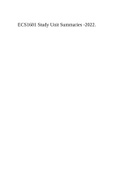ECS1601 Study Unit Summaries -2022.
, ECS1601
LEARNING UNITS 1
PRODUCTION, INCOME AND SPENDING IN A MIXED ECONOMY
- REVISION
1.1 Make sure you remember the following from ECS1501:
What economics is all about (refer to section 1.1 of your textbook)
Economics is the science of household management, where the household may vary in size from an
individual living on his own to the economy of the country or the whole world.
The basic essence of economics – there are unlimited wants, while the means available to satisfy those
wants are limited.
What is studied in microeconomics and what is studied in macroeconomics
- Microeconomics focus on individual parts of the economy. In microeconomics, the decisions and
functioning of decision makers such as individual consumers, households, firms or other organisations
are considered.
- Macroeconomics is concerned with the economy as a whole. In macroeconomics, the focus is on the
big picture. We develop an overall view of the economic system and we study total (or aggregate)
economic behaviour. The emphasis is on topics such as:
- total production
- Total income
- Total expenditure
- Economic growth
- aggregate employment and unemployment
- the general price level
- Inflation and
- The balance of payments.
Why do we say that South Africa has a mixed economy?
The South Africa economy is one in which traditions plays a minor role, the Government an important role
and the market (and private initiative) the largest role.
1.2 Production, Income and Spending
Define nominal and real variables and distinguish between them
Nominal values – refers to values you can see e.g. you salary which is paid into your bank
account.
Real value – refers to the actual or essential value e.g. the actual value of what you can buy with
your salary or the purchasing power of your salary.
E.g., R5000 in 2000 and R5000 in 2022 is the same but the purchasing power of that amount is
different.
1
, Define stocks and flows, and distinguish between such variables
Stock variable – measured at a specific time e.g.
Flow variable – is measured over time. E.g.
STOCKS FLOWS
Stocks
and Measured at a particular point in time Has a Time dimension – only flows
NO time dimension measured over a period
are related
Water level of dam measured at a Flow of water into the dam measured
particular point in time (at 00:00 on over a period (1 May 2007 inflow
May 1 2007 capacity was 72,64%) was measured as 250 cubic meters
per second
Stock Takes Calculation of sales, profit or loss
Still pictures Moving pictures
Examples Examples
Wealth Income
Assets Profit
Liabilities Loss
Capital Investment
Population Number of births and deaths
Balance in savings account Saving
Unemployment Demand for labour
Gold reserves held by SA Res Gold sales, gold production
bank expenditure, savings, depreciation,
inventories, opening stock, interest, exports, imports, changes
wealth, foreign debt, loans, in inventory, lending, borrowing,
populations, savings, rent, profit, consumption etc.
investment, capital etc.
Stocks can only change as a result of flows
Prices are ratios between different flows
Ratios between a stock and flow and visa versa have a time dimension
Ratios between two stocks and two flows have no time dimension
Explain and illustrate the major flows in the economy and how they interact with each
other
The three major flows in the economy are:
- Total production
- Total income
- Total spending
Interaction between the three: Production creates income (earned) which is then used to
purchase the products.
2
, Define and explain the different factors of production, and their income
Land – rent for use of land
Labour – wages
Capital – Interest
Entrepreneur – Profit
Define and distinguish between the different components of total spending
o Households – are the basic decision-making units of the economy. A household consists
of an individual, a family, or a group of people who have a joint income and make decisions
together.
Members of the households consume goods and services to satisfy their needs, they are
therefore called consumers.
o Firms – may be defined as units that employ factors of production to produce goods and
services that are sold (seller) on the good market. Firms are buyers in the factors market.
Firms are the basic productive units in the economy. Firms are engaged in primarily
production.
o Government
- Local, Regional and National (Public Sector)
- Primary function – establish framework within which the economy operates
- Purchases factors of production from households (factor market)
- Purchases goods and services from firms (goods market)
- Provides households and firms with public goods and services
- In return taxes are paid and households and firms
- Government’s economic activity involves 3 important flows:
Government expenditure ( G )
Taxes ( T )
Transfer payments – e.g. wealthy to poor
• Injections into the basic circular flow of income and spending:
Government spending
Investments
Exports (X)
Leakages (withdrawal) from the flow of income between households and
firms:
Taxes
Savings
Imports (Z)
Taxes are a Leakage (withdrawal) from the flow of income between households and firms
because it is in a way spending money outside the market, hence creating a gap between
supply and demand. Taxes remove income from the economy.
o Foreign sector – South Africa has always had strong links with the rest of the world
therefore we are an open economy.
3




